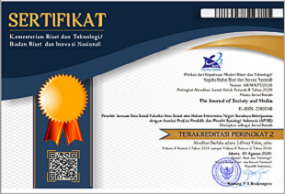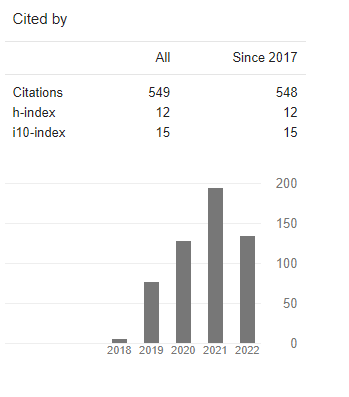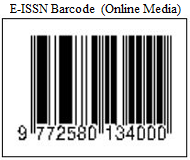Media Usage Motivations and Netflix Video Viewer Satisfaction in East Java
DOI:
https://doi.org/10.26740/jsm.v9n2.p504-538Keywords:
Netflix, Motivation, Media UseAbstract
Netflix is a subscription-based video streaming platform that offers a selection of films and documentaries each month. During the COVID-19 pandemic, streaming services experienced significant growth. This study examines the influence of Netflix media usage motivation on viewer satisfaction in East Java. It applies Guo and Chan-Olmsted’s Video Streaming Platform Representation Theory, McQuail’s Media Usage Motivation Theory, Blumer and Katz’s Uses and Gratification Theory, McMillan’s Interactivity Perception Theory, and Satisfaction Theory. Using a quantitative explanatory method, data were collected through an online questionnaire from 190 respondents and analysed using SPSS 26 and AMOS 22 with Structural Equation Modelling (SEM). The results indicate that Video Streaming Platform Representation, Media Usage Motivation, and Perception of Interactivity significantly influence viewer satisfaction, both simultaneously and partially. Media usage motivation—covering information seeking, personal identity, social integration, and entertainment—shows the most substantial effect. Viewers are satisfied because Netflix provides engaging information about new films and opportunities for interaction among users. The novelty of this study lies in distinguishing new media like Netflix from mainstream media, emphasising how streaming platforms enable users to access entertainment and exchange film- related information within online communities.
References
Afrinda, R. A. A., B. Irawan, and K. M. Boer. 2020. “Belimbing.id Interactivity Website as a Communication Media in Improving Public Service Systems in Belimbing Village, West Bontang District, Bontang City.” Communication World: Journal of Communication Science, Mulawarman University 8(1):88– 102.
Angelina, I. D., R. Rumani M., and I. W. 2015. “Analysis of Live Streaming Video Service Quality on Telkom University Local Network.” Post and Telecommunication Bulletin 12(3):207. https://doi.org/10.17933/bpostel.2014.120304.
Anisa, N., and V. Tjhin. 2023. “Factors Affecting Customer Loyalty Moderated by Switching Costs on Customer Satisfaction of Digital Streaming Services.” Journal of Management Systems and Sciences 13:1–20. https://doi.org/10.33168/JSMS.2023.0101.
Auvarda, C., and I. Irwansyah. 2022. “Effectiveness of Television Advertisements vs Retargeting Advertisements as Reminder Media in Society.” Indonesian
Journal of Communication Science 6(1):291–314. https://doi.org/10.25139/jsk.v6i1.3509.
Azis, A. 2017. “Motive Gap and Audience Satisfaction Level towards Performances.” Illc.
Budi, T. P. 2006. Applied SPSS 13.0: Parametric Statistical Research. Andi.
Chalaby, J. K. 2024. “Streaming Industry Platforms and the Economy: An Analysis.” Media, Culture and Society 46(3):552–571. https://doi.org/10.1177/01634437231210439.
Cuelenaere, E. 2024. “Can Netflix Original Films Be ‘Original’? Mapping and Understanding Content Recycling in the Age of Streaming Cinema.” Media, Culture and Society 46(5):991–1009. https://doi.org/10.1177/01634437231224081.
Dwivedi, Y. K., E. Ismagilova, D. L. Hughes, J. Carlson, R. Filieri, J. Jacobson, V. Jain, H. Karjaluoto, H. Kefi, A. S. Krishen, V. Kumar, M. M. Rahman, R. Raman, P. A. Rauschnabel, J. Rowley, J. Salo, G. A. Tran, and Y. Wang. 2021. “Defining the Future of Social Media and Digital Marketing Research: Perspectives and Research Proposals.” International Journal of Information Management 59:102168. https://doi.org/10.1016/j.ijinfomgt.2020.102168.
Edwin, J., and I. Irwansyah. 2021. “Motivation of Millennial Generation to Watch Streaming Services.” Journal of Global Communication 10(1):77–100. https://doi.org/10.24815/jkg.v10i1.20210.
Fatina, N. N., and I. Irwansyah. 2020. “Perception of Audience Interactivity towards the Interactive Film ‘Bandersnatch.’” Indonesian Journal of Communication Science 4(2):453. https://doi.org/10.25139/jsk.v4i2.1887.
Fungsirirat, P. 2020. “Analysis of Consumer Behavior on Video Streaming Using Conjoint Analysis Techniques.” 7(1):37–72.
Guo, M., and S. M. Chan-Olmsted. 2015. “Predictors of Interest in Social Television: How Perceived Program, Media, and Audience Characteristics Affect Social Engagement with Television Programs.” Journal of Broadcasting and Electronic Media 59(2):240–258. https://doi.org/10.1080/08838151.2015.1029122.
Hadi, Y. A. S. 2021. “Motives and Satisfaction of Watching the Soap Opera
Bawang Putih Berkulit Merah on ANTV (Quantitative Descriptive Study of
Surabaya Viewers in 2021).” Undergraduate Thesis.
Hallinan, B., and T. Striphas. 2016. “Recommended for You: Netflix Awards and Algorithmic Cultural Production.” New Media and Society 18(1):117–137. https://doi.org/10.1177/1461444814538646.
Hariyanto, D., and A. P. P. Mariyanto. 2020. “Motives for Watching the Vlog ‘Keluarga Beti’ on Arif Muhammad’s YouTube Channel.” Kanal: Jurnal Ilmu Komunikasi 8(2):67–72. https://doi.org/10.21070/kanal.v8i2.264.
Jensen, J. F. 1998. “Tracking ‘Interactivity’: A New Concept in Media and Communication Studies.” Critical Studies in Media Communication 12(1):185–204. https://doi.org/10.1080/15295039909367098.
Joseph, F., W. C. Black, and B. J. B. 2010. Multivariate Data Analysis.
International.
Lauren Pabst, N. 2024. “Time Spent Streaming Surges to Over 40% in June, Highest TV Usage Share in Nielsen’s The GaugeTM History.” https://www.nielsen.com/news-center/2024/time-spent-streaming-surges-to- over-40-percent-in-june-2024/.
Lievrouw, L. A., L. Angeles, and S. Livingstone. 2014. “Introduction to the Updated Student Edition of the Book Section.” January 2006:2015–2017.
Lobato, R. 2017. “Rethinking International TV Streaming Research in the Age of Netflix.” Television and New Media 19:152747641770824. https://doi.org/10.1177/1527476417708245.
McMillan, S. J., and J. S. Hwang. 2002. “Perceived Interactivity Measures: An Exploration of the Roles of Communication Direction, User Control, and Time in Shaping Interactivity Perceptions.” Journal of Advertising 31(3):29–42. https://doi.org/10.1080/00913367.2002.10673674.
McQuail, D. 2005. McQuail’s Mass Communication Theory.
Meza, L., and G. D’Urso. 2024. “The User’s Dilemma: A Qualitative Study of the Effects of Netflix’s Recommendation System on Choice Benefit.” Psychological Studies 69. https://doi.org/10.1007/s12646-024-00807-0.
Michaels, C. F., and C. Carello. 1981. Direct Perception.
Navastara, A. M., and P. Navitas. 2012. “The Impact of Residential Land Development on Land Price Dynamics in Surabaya.” 11th IRSA Congress (July). https://doi.org/10.13140/2.1.1649.2483.
Ramadhini, C., and I. D. Mayangsari. 2020. “Motives and Satisfaction of Viewers Watching Toyota Indonesia YouTube Web Channel Series.” 7(2):7158–7171. Riri, C. 2024. “Analysis of the Influence of Live Streaming, Hedonic Shopping Motivation, and Price Discounts on Impulse Buying (Study on Generation Z TikTok Social Commerce Users).” ECo-Buss 7(1):623–635.
https://doi.org/10.32877/eb.v7i1.1502.
Rubin, A. 2009. “Television Uses and Gratifications: The Interaction of Viewing Patterns and Motivations.” Journal of Broadcasting 27. https://doi.org/10.1080/08838158309386471.
Schachtner, C. 2020. The Narrative Subject: Storytelling in the Internet Age.
https://doi.org/10.1007/978-3-030-51189-0.
Setyawan, R. A., and Y. Marzuki. 2018. “Survey of Live Streaming and Video Chat Applications.” Informatics Engineering Study Program, Faculty of Engineering, Janabadra University 185–191.
Shi, Y., and J. Zhou. 2021. “Analysis of Foreign Video Streaming Services Entering China’s Streaming Media Market: A Case Study of Netflix.” ICPRSS 586:337–343.
Sihombing, L. H., P. Lestari, and J. Dante T. M. 2021. “The Impact of the COVID- 19 Pandemic on Conventional Cinemas and Online Streaming Services in Indonesia.” International Journal of Communication and Society 4(1):153–
162. https://doi.org/10.31763/ijcs.v4i1.337.
Siswoko, S. W. 2013. “The Influence of Social Status on Consumer Response of Blackberry Users at STIE Perbanas Surabaya.” Scientific Article 101:0–16.
Suciati, P., and B. M. Putra. 2022. “Indonesian Gen Z Consumer Preferences in Subscribing to Netflix in the COVID-19 Pandemic Era.” Journal of Media and Information Warfare 15(1):71–84.
Sujana, S., and Y. Yusni. 2024. “The Influence of Service Quality and Price
Perception on Customer Loyalty and Customer Satisfaction as Intervening
Variables.” Jurnal Ilmiah Manajemen Persatuan 12(4):1165–1178. https://doi.org/10.37641/jimkes.v12i4.2698.
Tang, W., and M. Wei. 2023. “Streaming Media Business Strategy and Audience- Centered Practices: A Comparative Study of Netflix and Tencent Video.” Global Online Media and Communication 2(1):3–24. https://doi.org/10.1515/omgc-2022-0061.
Tutar, Ö. F., and F. H. Turhan. 2023. “Digital Entertainment: Transformation of Leisure Activities.” Shanlax International Journal of Education 11(S1):16–
28. https://doi.org/10.34293/education.v11is1-oct.6365.
Udoakpan, N., and R. Tengeh. 2020. “The Impact of Over-the-Top Television Services on Pay Television Subscription Services in South Africa.” Journal of Open Innovation: Markets and Technological Complexity 6:139. https://doi.org/10.3390/joitmc6040139.
Uyanto, S. S. 2009. Data Analysis Guidelines with SPSS. Graha Ilmu.
Vestius Confido, J., and A. P. Komala. 2022. “Urgency of Lex Specialis in the Implementation of Over the Top (OTT) Video Streaming in Indonesia.” Visio Justisia Law Journal 2(2):101–126.
Wayne, M. L. 2018. “Netflix, Amazon, and Branded Television Content on Subscription Video-On-Demand Portals.” Media, Culture and Society 40(5):725–741. https://doi.org/10.1177/0163443717736118.
Wayne, M. L., and A. C. Uribe Sandoval. 2023. “Netflix Original Series, Global Audiences, and the Discourse of Streaming Success.” Critical Studies in Television 18(1):81–100. https://doi.org/10.1177/17496020211037259.
Wood, J. 2013. Interpersonal Communication: Everyday Interactions.
Wratsari, E. T. A. W., M. S. Junaedi, and M. N. Krisjanti. 2022. “The Use of Online Streaming Services During the COVID-19 Pandemic in Indonesia.” Performance 26(2):306–320. https://doi.org/10.24002/kinerja.v26i2.6068.
Yasin, Y., R. Husain, and A. H. Isa. 2021. “The Effectiveness of Using Zoom Cloud Meeting Media in Improving Student Motivation and Learning Outcomes.” International Journal of Innovation, Research and Engineering Technology
8(2):91–97.
Yusrin, N. A. 2024. “Understanding the Characteristics of Live-Streaming Success on Purchase Interest in Indonesia.” Ultima Management: Journal of Management Science 16(1):107–125.
Zaban, R., and P. Plaut. 2024. “The Relationship Between Activities Performed in the Physical and Digital Worlds: Lessons Learned from the COVID-19 Pandemic.” Sustainable Cities and Societies 106(March):105370. https://doi.org/10.1016/j.scs.2024.105370.
Zaila, K. E., V. Osadchiy, A. S. Anderson, S. V. Eleswarapu, and J. N. Mills. 2020. “Popularity and Global Reach of a Targeted, Evidence-Based Internet Streaming Video Intervention Focused on Men’s Health Topics.” Translational Andrology and Urology 9(3):1374–1381. https://doi.org/10.21037/tau-20-580.
Zaqiwali, D. 2021. “Video Streaming Representation Platform in Viewer Satisfaction.” 2(7).
Zhang, H., S. Zheng, and P. Zhu. 2024. “Why Indonesian Consumers Purchase on Live Streaming Platforms? A Study on Consumer Perceived Value Theory.” Heliyon 10(13):e33518. https://doi.org/10.1016/j.heliyon.2024.e33518.
Downloads
Published
How to Cite
Issue
Section
License
Copyright (c) 2025 The Journal of Society and Media

This work is licensed under a Creative Commons Attribution 4.0 International License.
 Abstract views: 195
,
Abstract views: 195
, PDF Downloads: 114
PDF Downloads: 114












